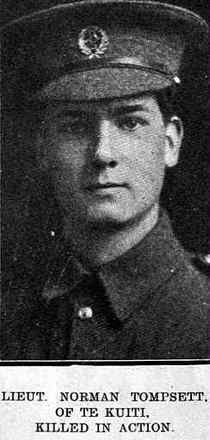2nd Lt
Norman Tompsett
Information about birth
|
Date of birth: 06/11/1894 |
|
Place of birth: Yalding, Kent, England, United Kingdom |
General information
|
Profession: Architect |
Army information
|
Country: New Zealand |
|
Force: New Zealand Expeditionary Force |
|
Rank: Second Lieutenant |
|
Service number: 12/2495 |
|
Enlistment date: 15/02/1915 |
|
Enlistment place: Trentham, Wellington, New Zealand |
|
Units: — Otago Regiment, 2nd Bn. (Last known unit) |
Information about death
|
Date of death: 12/10/1917 |
|
Place of death: Bellevue 's, Graventafel, Belgium |
|
Cause of death: Killed in action (K.I.A.) |
|
Age: 22 |
Memorial
|
Tyne Cot, New Zealand Apse Panel: 3 |
Distinctions and medals 3
|
1914-15 Star Medal |
|
British War Medal Medal |
|
Victory Medal Medal |
Points of interest 3
| #1 | Place of birth | ||
| #2 | Enlistment place | ||
| #3 | Place of death (approximate) |
My story
Norman Tompsett was born late 1894 in Yalding, Kent. He was the son of Mercy and Benjamin Tompsett. Once he had completed his studies, Norman emigrated to New Zealand, where he started working as an architect. In February 1915 he volunteered for the New Zealand Expeditionary Force. By the Battle of Passchendaele Norman had been promoted to Second Lieutenant and served with the Otago Regiment, 2nd Battalion, part of the 2nd New Zealand Brigade of the New Zealand Division.
Norman’s Battalion was to attack on the 12th of October 1917. The main goal was to reach to northern outskirts of the Passchendaele village.The 2nd NZ Brigade was to attack with the 2nd Bn. Otago Regiment, the 1st Bn. Otago Regiment and the 1st Bn. Canterbury Regiment. The 2nd Bn. Canterbury Regiment was in reserve. The three objectives were allotted in this order.
The attack began at 5.25 a.m. with the 2nd Otago’s positioned at the front and thus leading the assault. On their right was the Ravebeek, that could be used as a guideline to reach Passchendaele. But shortly after, they got into difficulties because of uncut wire entanglements in front of the Bellevue Ridge. Because the opening barrage didn’t cause much damage and therefore was negligible. The only gap in the wire was at a single point on the sunken Graventafel Road. While some soldiers tried to cut some paths through the wires, many soldier went to that single open point, which turned out to be a death trap. The area of the Bellevue Spur was overloaded with German defences and pillboxes. German machineguns mowed the Otago’s down and caused many casualties.
The other battalions faced the similar problems, so they also couldn’t get any further and failed to reach the Red Line. The 12th of October 1917 will be remembered as one of the most tragic days in the history of the New Zealand Army and would later be known as the Tragedy of the Bellevue Spur.
Second Lieutenant Norman Tompsett , 22-years old, was killed in action during the attack on Bellevue. He has no known grave and is remembered on the Tyne Cot, New Zealand Apse.
Norman’s Battalion was to attack on the 12th of October 1917. The main goal was to reach to northern outskirts of the Passchendaele village.The 2nd NZ Brigade was to attack with the 2nd Bn. Otago Regiment, the 1st Bn. Otago Regiment and the 1st Bn. Canterbury Regiment. The 2nd Bn. Canterbury Regiment was in reserve. The three objectives were allotted in this order.
The attack began at 5.25 a.m. with the 2nd Otago’s positioned at the front and thus leading the assault. On their right was the Ravebeek, that could be used as a guideline to reach Passchendaele. But shortly after, they got into difficulties because of uncut wire entanglements in front of the Bellevue Ridge. Because the opening barrage didn’t cause much damage and therefore was negligible. The only gap in the wire was at a single point on the sunken Graventafel Road. While some soldiers tried to cut some paths through the wires, many soldier went to that single open point, which turned out to be a death trap. The area of the Bellevue Spur was overloaded with German defences and pillboxes. German machineguns mowed the Otago’s down and caused many casualties.
The other battalions faced the similar problems, so they also couldn’t get any further and failed to reach the Red Line. The 12th of October 1917 will be remembered as one of the most tragic days in the history of the New Zealand Army and would later be known as the Tragedy of the Bellevue Spur.
Second Lieutenant Norman Tompsett , 22-years old, was killed in action during the attack on Bellevue. He has no known grave and is remembered on the Tyne Cot, New Zealand Apse.
Sources 6
|
"Passchendaele. The Day-by-Day Account", McCarthy C., London, Uniform, 2018, pg. 128-132. Sources used |
|
"The Official History of the Otago Regiment N.Z.E.F. in the Great War 1914-1918", Byrne A.E., Dunedin, Wilkie & Co Ltd., pg. 207 - 228. Sources used |
|
Ancestry https://www.ancestry.com/ Further reference |
|
Auckland Cenotaph https://www.aucklandmuseum.com/war-memorial/online-cenotaph/record/C15870?n=12%2F2495&w=World%20War%20I%2C%201914-1918&ordinal=0&from=%2Fwar-memorial%2Fonline-cenotaph%2Fsearch Sources used |
|
CWGC https://www.cwgc.org/find-war-dead/casualty/848263/tompsett,-norman/ Sources used |
|
The Long, Long Trail http://www.longlongtrail.co.uk/army/ Sources used |
